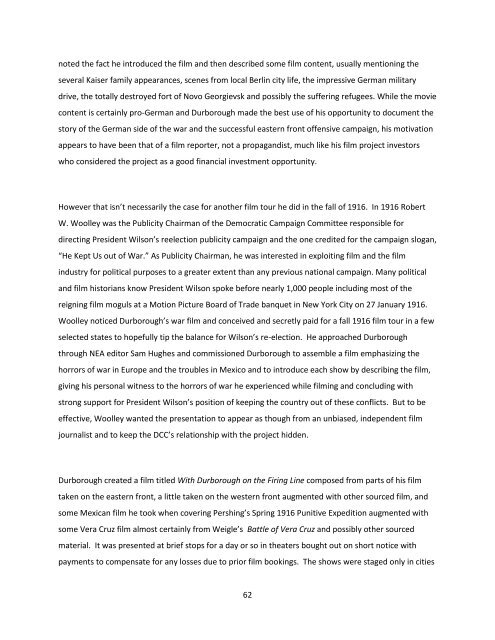"On the Firing Line with the Germans" Film Annotations (2017)
Film annotations, describing the making of Wilbur H. Durborough's World War I feature film "On the Firing Line with the Germans (USA, 1915) by authors Cooper C. Graham, Ron van Dopperen and James W. Castellan (April 2017). For more information visit our weblog http://shootingthegreatwar.blogspot.nl The movie can be watched on our YouTube channel: https://youtu.be/958QR_Cdg5U
Film annotations, describing the making of Wilbur H. Durborough's World War I feature film "On the Firing Line with the Germans (USA, 1915) by authors Cooper C. Graham, Ron van Dopperen and James W. Castellan (April 2017).
For more information visit our weblog http://shootingthegreatwar.blogspot.nl
The movie can be watched on our YouTube channel:
https://youtu.be/958QR_Cdg5U
Create successful ePaper yourself
Turn your PDF publications into a flip-book with our unique Google optimized e-Paper software.
noted <strong>the</strong> fact he introduced <strong>the</strong> film and <strong>the</strong>n described some film content, usually mentioning <strong>the</strong><br />
several Kaiser family appearances, scenes from local Berlin city life, <strong>the</strong> impressive German military<br />
drive, <strong>the</strong> totally destroyed fort of Novo Georgievsk and possibly <strong>the</strong> suffering refugees. While <strong>the</strong> movie<br />
content is certainly pro-German and Durborough made <strong>the</strong> best use of his opportunity to document <strong>the</strong><br />
story of <strong>the</strong> German side of <strong>the</strong> war and <strong>the</strong> successful eastern front offensive campaign, his motivation<br />
appears to have been that of a film reporter, not a propagandist, much like his film project investors<br />
who considered <strong>the</strong> project as a good financial investment opportunity.<br />
However that isn’t necessarily <strong>the</strong> case for ano<strong>the</strong>r film tour he did in <strong>the</strong> fall of 1916. In 1916 Robert<br />
W. Woolley was <strong>the</strong> Publicity Chairman of <strong>the</strong> Democratic Campaign Committee responsible for<br />
directing President Wilson’s reelection publicity campaign and <strong>the</strong> one credited for <strong>the</strong> campaign slogan,<br />
“He Kept Us out of War.” As Publicity Chairman, he was interested in exploiting film and <strong>the</strong> film<br />
industry for political purposes to a greater extent than any previous national campaign. Many political<br />
and film historians know President Wilson spoke before nearly 1,000 people including most of <strong>the</strong><br />
reigning film moguls at a Motion Picture Board of Trade banquet in New York City on 27 January 1916.<br />
Woolley noticed Durborough’s war film and conceived and secretly paid for a fall 1916 film tour in a few<br />
selected states to hopefully tip <strong>the</strong> balance for Wilson’s re-election. He approached Durborough<br />
through NEA editor Sam Hughes and commissioned Durborough to assemble a film emphasizing <strong>the</strong><br />
horrors of war in Europe and <strong>the</strong> troubles in Mexico and to introduce each show by describing <strong>the</strong> film,<br />
giving his personal witness to <strong>the</strong> horrors of war he experienced while filming and concluding <strong>with</strong><br />
strong support for President Wilson’s position of keeping <strong>the</strong> country out of <strong>the</strong>se conflicts. But to be<br />
effective, Woolley wanted <strong>the</strong> presentation to appear as though from an unbiased, independent film<br />
journalist and to keep <strong>the</strong> DCC’s relationship <strong>with</strong> <strong>the</strong> project hidden.<br />
Durborough created a film titled With Durborough on <strong>the</strong> <strong>Firing</strong> <strong>Line</strong> composed from parts of his film<br />
taken on <strong>the</strong> eastern front, a little taken on <strong>the</strong> western front augmented <strong>with</strong> o<strong>the</strong>r sourced film, and<br />
some Mexican film he took when covering Pershing’s Spring 1916 Punitive Expedition augmented <strong>with</strong><br />
some Vera Cruz film almost certainly from Weigle’s Battle of Vera Cruz and possibly o<strong>the</strong>r sourced<br />
material. It was presented at brief stops for a day or so in <strong>the</strong>aters bought out on short notice <strong>with</strong><br />
payments to compensate for any losses due to prior film bookings. The shows were staged only in cities<br />
62



